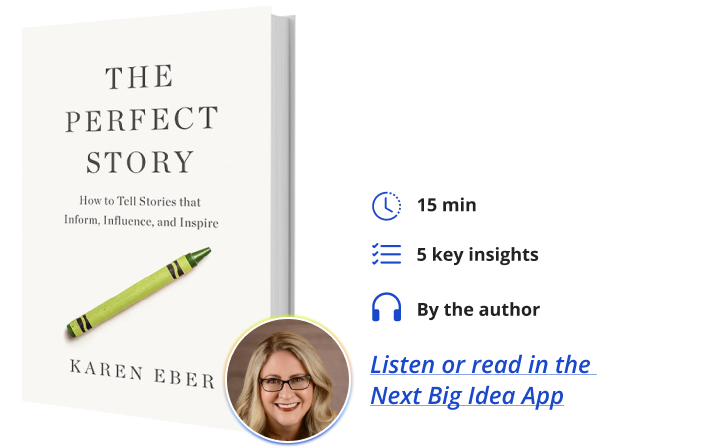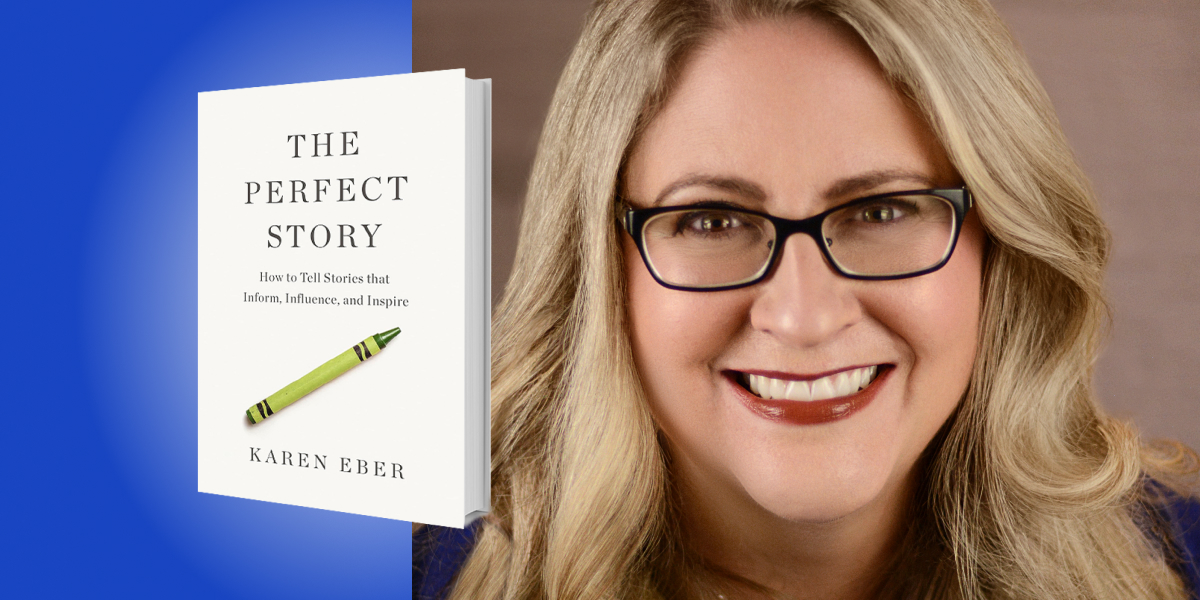Karen Eber is a TED and keynote speaker, and an international consultant. She is the CEO and Chief Storyteller of Eber Leadership Group, where she works with Fortune 500 companies on how to build their leaders, teams, and culture, one story at a time.
Below, Karen shares 5 key insights from her new book, The Perfect Story: How to Tell Stories that Inform, Influence, and Inspire. Listen to the audio version—read by Karen herself—in the Next Big Idea App.

1. We are not hard-wired for stories.
If we were, every story we experience would be captivating. It’s like saying we’re hard-wired to run marathons. You may have the physical components, but if you don’t prepare them, you will be in a world of hurt. The same is true for stories. It’s not enough to tell a story, the way you tell a story makes a difference in the experience.
Storytelling is an art grounded in science. There are fundamental ways our brains interact with and process information, which aids in survival, understanding, communication, and decision-making. Consequently, our mental defaults impact how we interact with stories. I call these “The Five Factory Settings of the Brain.”
Think of those days when you turn on a favorite show or movie because you don’t want to “think.” Or your mind drifts off during a meeting while someone is speaking. That is because of the first factory setting: your brain is lazy. The brain has one goal and that is to get you through the day alive. To do so, it uses 20 percent of your body’s overall calories—more than any other organ. The majority of these calories are spent making predictions for things like how to move your body to stand up from a chair. It’s a stingy banker who never wants to go bankrupt of calories.
What this means for stories and communication is that your brain is always looking for opportunities to conserve calories. As Dr. Paul Zak once said to me, “Your audience is either going to listen or read what you’ve created or watch cat videos.” Stories that don’t include specific details or build tension and conflict can cause the brain to drift off.
“Your brain is lazy.”
Your brain also hates incomplete things. Do you know how you guess the ending of a movie or book? Or can anticipate what a person is going to say? This is because of the second factory setting: your brain makes assumptions. The faster the brain makes predictions about what will happen, the faster it can conserve calories. In stories, this means we either need to slow down assumptions by putting in unexpected details and plot points– or we lean into them and make them more dynamic with descriptions.
Our brain’s ability to make assumptions and predictions is because of our third factory setting: we have this library of knowledge and experiences. When we take in information through our senses, those experiences get stamped with emotions and stored in our long-term memory. It’s a bit like when you take a photo on your phone, swipe up, and see it has automatically been stamped with the date, location, f-stop, and aperture. Our brain then scans this library of files to make predictions and assumptions. When we tell a story, we want to engage the senses and emotions of the audience. It not only helps them feel immersed, it let’s the story be stored as part of their long-term memory.
The fourth factory setting seeks people that have similar likes, interests, values, or aspirations. It also notices when it feels different as a member of an out-group. The charity that tells the story of one person after a natural disaster uses out-groups. You hear how they lost their home and are struggling to get clothing, electricity, and food while you are sitting in a home with air conditioning and feel inspired to donate. When you tell stories, you choose if you are telling a story that makes someone feel part of something, or different.
The fifth factory setting is our basic pursuit of pleasure while avoiding pain. Cortisol and adrenaline are released to help us focus and avoid pain or danger. Serotonin, dopamine, and oxytocin are released in feel-good moments. Every story is designed to be either a feel-good story, an uncomfortable one, or both.
The Five Factory Settings of the Brain help you understand what should be included in a story to captivate your audience.
2. Build a toolkit of endless ideas.
The best time to come up with a potential idea for a story is when you don’t need it. This is when your brain is relaxed and does its best thinking. This is the time to build a list of ideas that you can consult when you have the opportunity to tell a story.
The best story ideas come through constraints. If I asked you to describe your childhood, you’d likely respond with the city you grew up in, what type of housing you had, and how many family members were around. Your response would be general because childhood is full of endless stories and experiences. The question is too broad to prompt thinking. But if I ask you, “What sound or smell reminds you of home?” you would have endless stories. The constraint tells your brain which file in your mental library to access.
“Capture as many different ideas as you can without worrying about how you will use them.”
To come up with ideas, start with your own experiences. Think about your professional experiences. Your first job, a mistake or failure, or something you are proud of. Think through your personal life: What is something you should’ve thrown out but have held onto? What is a hidden talent of yours? Expand this to include things that fascinate you: museums, articles, podcasts. Make a list of ideas that come up.
The goal is to capture as many different ideas as you can without worrying about how you will use them. You will look through this list when opportunity strikes and determine which one will build the outcome you want for the audience.
3. Data never speaks for itself.
There is often a bias in business to favor data over stories. However, it isn’t an either/or decision. Stories connect your audience to the data and help them understand it.
If I showed a group an image of an inkblot, each person would have a different interpretation. Some might see a mouse; others might see a skeleton. That is because our brains are making assumptions trying to discern the image. Those assumptions draw upon each person’s library of files. There are different interpretations because there are different experiences.
The same thing happens when we put up data. You’ve likely experienced this in meetings when there is a debate about the quality of the data, the source of the data, or even what it means. When you don’t tell the story of the data, you risk everyone having a different interpretation. It’s impossible to make a data-informed decision when everyone has a different understanding of the data.
A podcast host once said to me, “Some people avoid telling stories because data can be shared quickly. Stories require work.” Just because it’s easy to share information doesn’t mean the audience understands or remembers it. The audience needs guidance to understand the data.
Storytelling with data begins before collecting it. People often gather reams of data and then start picking pieces of it. It’s a bit like defining the scientific hypothesis for your experiment after you conduct it. More data isn’t better. More confuses the audience. Start defining what problem you are trying to solve first, then lay out the story as you gather data.
Not every piece of data needs a story. If you have a regular weekly meeting to review a dashboard, you may not need a story each week. But when you start to notice outliers in what you are monitoring, tell those stories.
4. Focus on yourself, or fail to plan, and your story can go wrong.
One common storytelling mistake is telling the story we want to tell and not the one the audience needs to hear. These are our greatest hits. We love to tell them. The problem is that we often forget to make the idea relatable to the audience. It’s like an uncle at the holiday table. You don’t even need to be present; he’s telling that story for himself.
Stories begin with the audience, not the idea. You must know what you want your audience to feel or think after the story. Think about where their mindset is today and what might be an obstacle to what you want them to know, think, feel, or do. Your story starts here because this makes sure your message is focused on your audience. Starting with the idea leads to talking at listeners instead of engaging them. Each time you tell a story it’s going to be different because each audience is different.
“You must know what you want your audience to feel or think after the story.”
Another common mistake is telling a story without planning a basic structure for it. They ramble, and it’s hard to follow. Taking a few minutes to structure the story helps make it not only easier for you to tell it, but easier for the audience to listen.
A third common mistake is that people don’t leave themselves enough time to work on their story. A story in a one-on-one can be told on the fly. But if you are giving a presentation, you need to spend time planning it. Many people spend hours tinkering with slides and spend five minutes thinking about what they will say. Flip that. Structure makes all the difference in how your story lands.
5. Telling great stories isn’t about finding the perfect story.
I have a brown eye and a green eye. I have always loved my eyes. They make me special. People are more inclined to remember my different-colored eyes than to remember my name. But as much as I loved them, I soon realized people didn’t know what to make of them. I came to recognize the exact moment when people would notice them. Their words would slow and stop mid-sentence and their eyes darted back and forth from my right to my left. I braced myself for what always came next.
“Hey, did you know you have two different-colored eyes?!” Sometimes for fun, I would gasp and exclaim “No! Really?!” At this point, they would call other people over, followed immediately by a barrage of questions. This was the moment that made everything uncomfortable. Everyone was staring at me. I felt like a circus sideshow act expected to perform a trick. I was being viewed as weird and different. I hated these moments; they always left me feeling depleted.
One day I was frustrated by the pelting of questions and decided to change the energy by telling the following story: I was born with brown eyes. When I was four, I was coloring in my room one evening. Dinner wasn’t going to be for a few more hours, and I was hungry. You know that big box of crayons we all have? The ones we throw the broken, peeled, and perfect ones in? I dug into that box and pulled out a green crayon. I sniffed it and it didn’t smell like much. I took a nibble and was surprised at how much I liked the taste, so I ate it. Then I ate another one and another until every green crayon in the box was gone. The next day I woke up and my left eye was green.
Then I would be quiet. This silence was usually followed by sideways looks and arched eyebrows. I would let them off the hook and say, “No, of course, I didn’t eat crayons” and we would laugh. It created a shift away from me and onto the story. It was less uncomfortable, and I didn’t feel depleted. Instead of stares and scrutiny, I got smiles. The story often inspired apologies once people realized the silliness of their questions. The conversation always transitioned to a meaningful connection. People have remembered this story for over 30 years, commenting that they think of me when they see crayons.
Great stories aren’t sitting on a shelf waiting for you to select them. They are developed from within you. It’s about finding the ideas you have and shaping them into the perfect story for each audience.
To listen to the audio version read by author Karen Eber, download the Next Big Idea App today:































